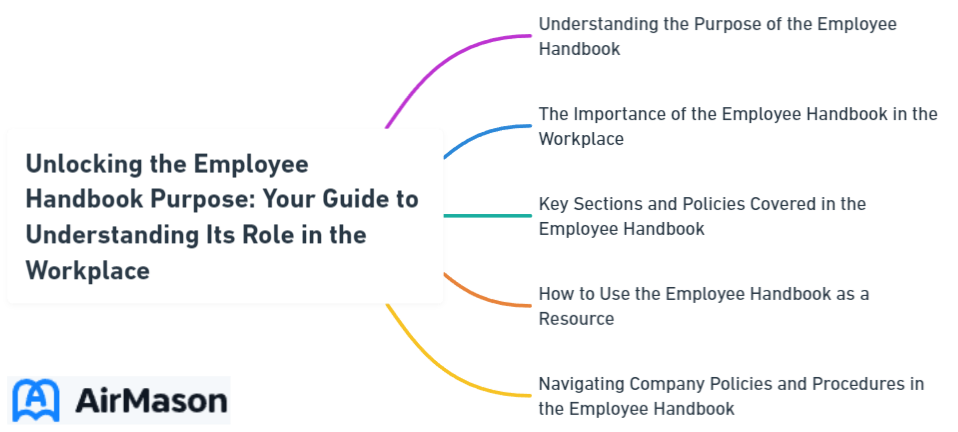
Understanding the employee handbook purpose is essential for any organization. These documents serve as a cornerstone for both new and existing employees, guiding them through company policies, expectations, and cultural norms. But what exactly is the fundamental employee handbook purpose? It acts as a vital tool for communication, clarity, and legal compliance within the workplace, setting out the terms of the employment relationship. This article explores how these handbooks establish company culture, clearly outline employee expectations, and provide important legal protections for both the employee and employer.
Key Takeaways
- An employee handbook is a crucial communication tool that outlines company policies, reinforces culture and values, and sets clear expectations for employee conduct, aiming to ensure consistency and a positive work environment.
- The handbook must be comprehensive, including key components such as detailed company policies and procedures, compensation and benefits information, and onboarding and offboarding processes, to serve as a complete guide for employees.
- Regularly updating and communicating changes in the employee handbook is essential for maintaining relevance, legal compliance, and consistency in the workplace; this includes involving legal review and distributing updates through various channels.
Employee Handbook Contents
When looking for employee handbook contents, it’s crucial to consider the comprehensive range of topics that should be covered to provide clear guidelines and expectations for employees. The contents of an employee handbook typically include essential information such as company policies, codes of conduct, employee benefits, procedures for time off and leave, and guidelines for workplace behavior. These contents serve as a roadmap for both employees and employers, outlining the rights, responsibilities, and expectations within the organization. Additionally, the handbook may encompass information on workplace safety protocols, disciplinary procedures, and avenues for conflict resolution. By outlining these key components, the employee handbook becomes a valuable resource for promoting consistency, transparency, and compliance across the organization.
The Core Purpose of Employee Handbooks

An employee handbook fundamentally serves as a communication tool. It outlines company policies, reinforces the company’s culture and values, and provides clarity on professional expectations. The handbook provides a framework for workplace behavior, setting clear expectations for how employees should conduct themselves and perform their duties, thus ensuring consistency throughout the organization.
A strong employee handbook fosters a positive work environment by promoting transparency and consistency across an organization. The main function of an employee handbook is to orient and enlighten employees, thereby boosting their confidence and engagement with the company. If you’ve ever felt lost or confused about company policies and procedures, a well-drafted employee handbook is your compass and guide.
Establishing Company Culture
The company’s culture fuels its operations, and the employee handbook significantly contributes to defining and conveying this culture. It details the company’s mission, vision, and values, attracting and retaining employees aligned with these principles. It serves as a platform to welcome new employees, introducing them to the company’s culture and values, thereby helping them understand their place and purpose within the organization.
Maintaining a consistent tone and straightforward communication in the handbook helps employees grasp the company culture and expectations, thereby enhancing the handbook’s effectiveness as a cultural instrument. Including an organizational chart and detailed company mission, vision, and values in the employee handbook helps employees grasp the company’s structure and their roles more clearly.

Setting Clear Expectations for Employees
A well-crafted employee handbook can establish clear expectations for employees, aiding them in comprehending their roles and responsibilities within the organization. It establishes behavior protocols and performance benchmarks by including a comprehensive code of conduct, delineating acceptable employee behavior, uses of company-owned devices, social media, and general communications expectations. This way, employees know how to conduct themselves professionally and responsibly.
The handbook underscores the organization’s commitment to transparency, equitable treatment, and the cultivation of a positive and fair workplace culture. Clear job responsibilities are articulated within the handbook, providing a guide for employees on what is expected of them, and what they can expect from leaders. This level of clarity is not just good for morale, but also for the overall productivity and success of the company.
Providing Legal Protection
Beyond defining company culture and setting expectations, the employee handbook fulfills a pivotal role in offering legal protection. Clearly defining workplace policies and procedures in the employee handbook is critical for defending the business against employee lawsuits and claims.
The handbook ensures compliance with federal and state laws, clearly communicating various entitlements and obligations to employees, and demonstrating an organization’s effort to comply with regulations. It’s also essential to include equal employment and non-discrimination policies, as well as workplace safety guidelines, to comply with laws like the Occupational Safety and Health Act (OSHA) and inform employees of their protections.
Essential Components of an Effective Employee Handbook

An effective employee handbook goes beyond being a mere compilation of policies and procedures. It’s a comprehensive guide that also includes compensation and benefits information, and onboarding and offboarding processes. Providing the handbook in various formats, such as printed copies and digital versions, increases employee access and engagement.
Interactive features like videos and quizzes can make the handbook more engaging for employees. Encouraging employees to give feedback on the handbook fosters a sense of ownership and aids in its continuous improvement. Including an acknowledgment form ensures employees confirm their understanding of the handbook’s contents.
Handbook for Managers
In any organization, having a comprehensive handbook for managers is essential for ensuring smooth operations and effective leadership. A handbook for managers serves as a vital resource, providing guidance on company policies, procedures, and best practices for managing teams and achieving organizational goals. From outlining expectations and responsibilities to offering tips for conflict resolution and employee development, a well-crafted handbook for managers plays a crucial role in fostering a positive work environment and driving success. With clear communication and actionable insights, this handbook equips managers with the tools and knowledge they need to lead with confidence and integrity.
Policies and Procedures
Policies and procedures form the fundamental structure of any effective employee handbook. These should articulate clear policies regarding:
- Attendance
- Confidentiality, including the handling of an employee’s personnel file
- Workplace behavior
- Response measures to misconduct, such as anti-harassment policies.
Handbooks must also include an acknowledgment section for employees to confirm their understanding and agreement to abide by the policies. They also provide guidance on procedures for everyday work situations such as unscheduled absences or raising policy-related queries.
Ensuring that policies are written in clear, concise, and easy-to-understand language helps prevent misunderstandings and maintains a supportive work environment aligned with company values.
Compensation and Benefits Information
Compensation and benefits information represent another vital part of an effective employee handbook. The handbook should outline compensation details including:
- Payroll structure
- Salary increases
- Bonus or stock options
- Overtime rules
- Payment schedules
It should also detail leave policies, such as:
- how employees earn and schedule time off
- sick leave
- paid holidays
- legally required leaves
This information is crucial for managing work-life balance. Benefits like health insurance, 401(k) plans, and other perks should be clearly described, specifying eligibility and the procedures to enroll.
Onboarding and Offboarding Processes
Onboarding and offboarding procedures, as well as the employment agreement, should be clearly outlined in the employee handbook. This includes orientations about pay periods, benefit waiting periods, and guidelines for promotion, which helps new hires integrate into the company smoothly.
Clear offboarding procedures help manage expectations and avoid confusion or disputes during employee departures, whether through quitting, layoffs, or termination. Including an explanation of the company’s recruitment and selection process in the handbook offers transparency and sets fair expectations for current and prospective employees.
The Role of Employee Handbooks in Promoting Consistency

Promoting consistency is one of the significant benefits derived from having an employee handbook. Consistently communicated policies help to:
- Eliminate confusion and inconsistencies, ensuring a fair and organized work environment
- Set clear expectations, reducing confusion and the risk of disciplinary actions
- Serve as a reference for permissible actions
Keeping staff informed about changes in policies and procedures is critical for maintaining:
- clarity
- consistency
- compliance
- transparency
When clear policies are in place and implemented fairly, everyone can expect to be treated with respect and without harassment or discrimination. This promotes a positive and inclusive environment for all, reducing the likelihood of unfair treatment claims and establishing uniform company wide expectations.
Uniformity Across Departments
The employee handbook serves a key function in maintaining uniformity of company policies and practices across disparate departments and management levels. A consistent set of rules and policies across all departments is vital for maintaining fairness within the organization.
By providing a uniform set of guidelines, the employee handbook:
- Prevents individual department managers from following personal preferences, thus upholding organization-wide consistency
- Ensures that there is no unfair treatment or discrimination within the company
- Fosters a more inclusive and equitable work environment.
Guiding Management Decisions
Not only is the employee handbook for employees, but it also acts as an invaluable resource for management, supplying a standardized framework that steers all managers towards making consistent decisions and preserving fairness in the workplace. In this sense, the employee manual serves a similar purpose.
Employee handbooks play a crucial role in informing management about expectations and maintaining a commitment to company values and professional conduct within the employment relationship. Management relies on the handbook for consistent enforcement of policies, ensuring legal compliance and reducing the risk of discrimination or unfair treatment.
Regular training on and review of the employee handbook ensures that management is following current policies and accurately enforcing them. It is important to update and consult the employee handbook regularly to maintain a well-informed workforce.
Keeping Your Employee Handbook Current and Relevant

Relevance is a key characteristic of an effective employee handbook. It should be treated as a living document and regularly amended and updated, adhering to internal standards for review frequency.
Updating the employee handbook is essential for compliance with legal changes, as failure to integrate new laws into policies and procedures can lead to significant legal issues for employers. Outdated handbooks can lead to:
- Confusion
- Perceptions of unfair treatment
- Inconsistencies in practice
- Misalignment with the company’s current mission or values
Regular updates are necessary to mitigate these risks.
Periodic Reviews and Updates
Frequent reviews and updates of the handbook are indispensable for maintaining its accuracy, relevance, and legal compliance. HR should note necessary updates throughout the year, and involve executive leadership or an employee committee, including legal review, in the handbook review process.
Annual reviews are recommended for ensuring the handbook remains current and legally compliant. Establishing a clear review schedule can help in maintaining the employee handbook as a current and accurate resource. Engaging an employment attorney during updates can help identify and mitigate potential legal risks and ensure compliance.
Communication of Changes
Swift communication of handbook updates to employees is essential in preserving clarity, uniformity, and adherence to rules. Employee handbook updates can be distributed through various methods, including:
- New-hire orientation
- Manual distribution
- Posting on the company intranet
- Internal email
- Annual training sessions
Immediate notification to employees is crucial upon revising the employee handbook, with advance notice for upcoming changes and prompt responses to their questions and concerns. Engaging with staff to address their questions and concerns about handbook changes is important.
Training and Employee Engagement with the Handbook

To ensure the handbook’s effectiveness, training and employee engagement are paramount. Effective training on the employee handbook, such as orientation sessions and workshops, is crucial to ensure that employees are well-informed about their obligations, which leads to compliance and trust in the workplace.
Using versatile training tools like e-learning platforms, along with traditional methods such as in-person training sessions, can significantly enhance the accessibility and understanding of the employee handbook’s content. Managers are encouraged to create an open environment where employees feel comfortable asking questions and providing feedback on the handbook.
Employee Training on Policies and Procedures
Effective training on the employee handbook guarantees that employees are thoroughly educated about their obligations. Employee training sessions or workshops are crucial in educating staff on the contents of an employee handbook.
Visual aids and examples, as well as scenarios and case studies, can significantly enhance the understanding of policies and procedures during employee handbook training. Providing training support when introducing new policies and performance assessments reinforces the handbook’s guidelines and improves compliance among employees.
Encouraging Feedback and Open Dialogue
Promoting feedback and an open dialogue about the handbook is vital for its ongoing enhancement. Involving the entire staff in the review process and requesting their input fosters their engagement and feedback on the handbook.
Hosting open forums allows employees to express their opinions and suggestions, which enhances their engagement and sense of ownership over the employee handbook. Anonymous surveys can gather honest feedback from employees, pinpointing areas in the handbook that may require clarification or amendment.
Valve Employee Handbook
The Valve Employee Handbook is a unique document that reflects the company’s unconventional approach to management and workplace culture. Established as a guide for employees navigating their roles within the organization, the Valve Employee Handbook emphasizes autonomy, creativity, and collaboration. This handbook outlines the company’s philosophy on decision-making, organizational structure, and employee empowerment, encouraging individuals to take ownership of their work and pursue projects that align with their passions and interests. With its emphasis on trust and self-management, the Valve Employee Handbook serves as a cornerstone of the company’s commitment to fostering a dynamic and innovative work environment.
Summary
In summary, the employee handbook is a powerful tool that shapes your work environment, communicates company culture, sets clear expectations, and provides legal protection. It’s a document that needs to be crafted with care and updated regularly to reflect the current state of the company and the legal landscape. But more than that, it’s a testament to the company’s commitment to transparency, fairness, and consistency. So the next time you look at your employee handbook, remember, it’s not just a list of rules, it’s a roadmap to success.
Frequently Asked Questions
Why an employee handbook is important?
An employee handbook is important because it provides clarity on expected behavior and job performance, ensuring everyone works from the same page and provides a framework for workplace behavior.
What is the purpose of having a handbook?
A handbook serves as a way to communicate employee expectations and provide guidance for management and leadership, ensuring alignment throughout the company. It creates a framework for consistent understanding and operation within the organization.
What are the key components of an effective employee handbook?
In conclusion, the key components of an effective employee handbook are comprehensive policies and procedures, compensation and benefits information, and onboarding and offboarding processes. These elements help provide clarity and guidance to employees.
How does the employee handbook promote consistency?
The employee handbook promotes consistency by enforcing uniformity across departments and guiding management decisions, ensuring fair treatment for all employees.
How often should the employee handbook be updated?
The employee handbook should be updated regularly to ensure its accuracy, relevance, and legal compliance, so it is recommended to review and update it consistently.
Important Disclaimer:
Please be aware that the content on this page has been generated by using artificial intelligence language models and may contain errors, inconsistencies, or outdated information. It is provided as-is without any warranties or guarantees of accuracy.
We strongly recommend using this content as a starting point for further research. We disclaim any liability for damages or losses resulting from the use or reliance on this content.